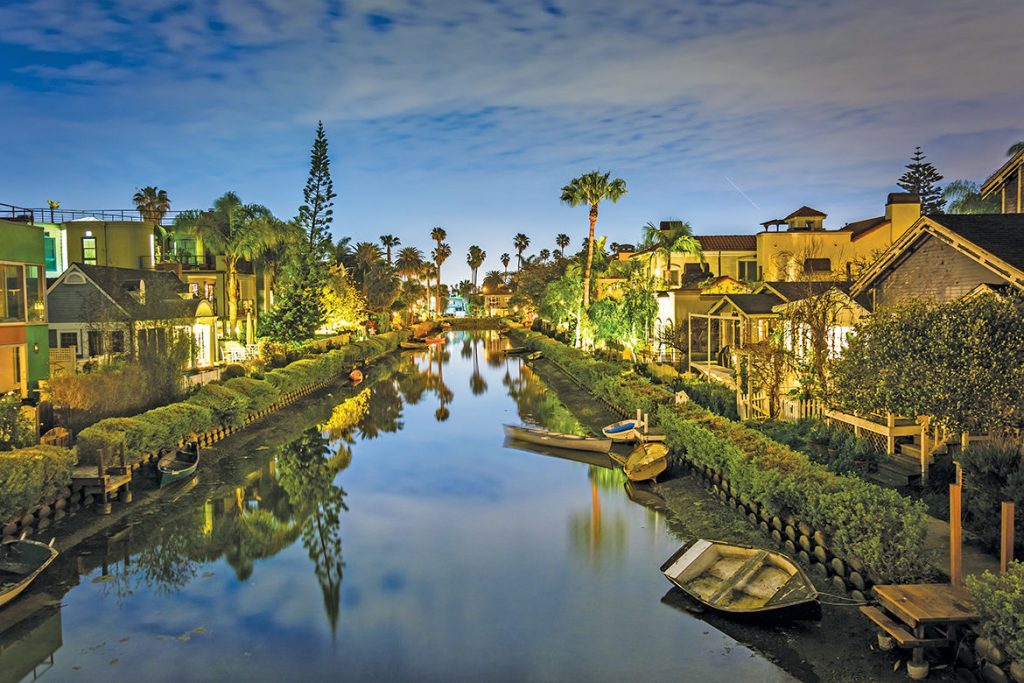In the 25 years I’ve lived in L.A., up until a few weeks ago, I’d never visited the Venice Canals: the brainchild, as you may know, of developer Abbot Kinney, who, back in 1905, thought to recreate a slice of Italy on the shores of the Pacific.
With the traffic on the 10, a trip from my perch near downtown to the Westside always requires a bit of mental preparation.
And Venice Beach, of course, is a world unto itself.
I grew up near the beach — granted, in New Hampshire — but even there, an air of thrillingly low adventure prevailed: drugs, clandestine sex, petty crime. Venice Beach features as well chalk-faced Midwestern families on vacation; man-bunned hipsters weaving through impossible traffic on expensive bikes and a caliber of female beauty not generally seen — or at least not quite so fully displayed — in New England.
I parked off Washington and navigated on foot by feel, winding through a few blocks of residential streets till I found my way to Grand Canal. It didn’t look grand: it looked like an alley lined with Home Depot garage doors.
But soon I came upon a quasi-charming white wooden bridge spanning a channel of water and the vista opened: lovely, surprising, strange.
The Santa Monica Mountains shimmered purple in the distance. Avocados, figs, fan palms and bougainvillea created a soft riot of color in the foreground. No skateboards, bicycles, or motorized vehicles of any kind, said the signs. “Protect the ducks,” another sign read. “Curb your dogs.”
Though I’d come near high tide, the water was low, murky brown and smelled faintly of rotting sea life (fish and aquatic birds are apparently plentiful; in early 2014, a few sharks even made their way in).
On an early afternoon weekday, the mood was pleasantly subdued: couples snapping pictures, a few leaf-blowers. The canals — two north-south and four east-west — have cement walkways on both sides, so you can go up, down, around and get in a good hour’s stroll.
I ranged at will, reveling in the roses bending their heads over picket fences, the amethyst lilies-of-the-Nile, the glimpses into people’s living rooms.
The canals were filled in as roads in 1929 and all but ruined by 1940. The surrounding residential district — roughly bounded by Grand, Carroll, Eastern and Sherman Canals — was listed on the National Register of Historic Places in 1982.
By 1993, the canals themselves had been fully resurrected. Houses now go for $3-4 million.
All the homes were nicely kept. One, built to resemble a peach stucco palazzo, featured curving wrought-iron outdoor staircases. Styles ranged from old-school bungalow courts to contemporary boxes of steel, glass and honey-colored wood, to mom-and-pop cottages, the front yards overgrown with succulents, agaves — and in one case, a collection of old doll heads.
Everyone had a balcony, or a front porch or a patio. Everyone seemed to have a little rowboat, beached on a patch of wet mud. Some folks had built tiny wooden piers and stuck a couple of lawn chairs out there.
We all want to make the world into our own image, and I thought of how L.A. maddeningly, gloriously, resists all such efforts. I thought of how we are all, in our way, immigrants.
Suddenly, my phone rang: a reporter asking if I had anything to say about the appointment of Father Robert Barron (with whom I’ve had the great pleasure of breaking bread) as one of three new auxiliary bishops for the archdiocese.
I thought back over my day:
The Morning Office I’d prayed in the hills of Echo Park.
The calls I’d made from the gridlocked freeway: to a friend visiting his elderly parents; to another friend struggling with depression.
The hipster bistro further up the beach I’d stopped into en route. A film shoot in front with tangled traffic. Gorgeous 20-somethings languidly taking selfies in the courtyard. The exit from the parking lot onto a fetid alley where a wizened Keith Richards-lookalike was passed out, Ray-Bans in place, on a pile of old clothes.
I said, “Welcome, Father Barron!” I said, “He will have a learning curve!” I said, “L.A. is a hard place to get your mind around. You just have to live here for a while.”
After hanging up, I thought, I hope Father Barron likes to walk. That is how I have grown to know and to love my city. That, and trudging anonymously to daily Mass.
For what is it to be “Catholic” but to love the place where we live? To care enough to slow down and listen to the heartbeat of the people around us? To know that each moment is consecrated, shot through with death and resurrection, paradox and mystery, dreams shattered and dreams fulfilled beyond our wildest imaginings?
I took surface streets home. On Venice Boulevard, just past Overland, I peered up Mentone Avenue, my address for the first two years after I moved to town. They’d painted the house where I used to live a different color. The guy behind was on my tail, but it looked like they might have put up a fence.
And all the way east — past the eternal snarl at Robertston, the inevitable jam at La Cienaga, that blessed smooth sail between La Brea and Crenshaw — I thought of a line from Hebrews: “Here we have no lasting city. We seek a home that is yet to come.”

